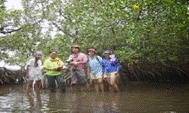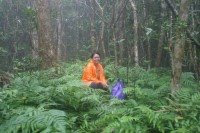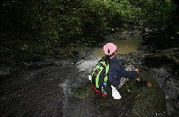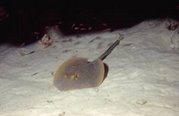From Health Today June 2004
In a small island down south, a marine turtle swims on the surface and spots what appears to be his favorite meal. It’s cloudy form drifts near the surface and undulates with the steady current. The hawksbill turtle paddles it weary arms to reach the jellyfish. It is hungry and tired having traveled thousands of miles to find the same beach where it was hatched years ago. The female turtle is ready to lay its eggs. Through instinct and natural navigation, it was able to come back in order to propagate its species. It chomps on what she thought was a jellyfish and swallows it. A few days later, a fisherman finds her on the shore, dead and poisoned by plastic.
Being an archipelago, the Philippines is blessed with a long coastline, extensive reef formations, beautiful islands, sand bars and warm tropical water. The seas surrounding our islands though are being tuned into veritable dumping grounds for a wide variety of trash. The ocean is becoming a waste receptacle since it seems to have the capacity to hold a huge amount and can conveniently hide it from the eyes of people. Unknown to many, the trash that ends up in the water, is not obliterated from existence. Non-biodegradable trash is scattered on the ocean floor and is continuously moved about by waves and currents, making it a perpetual killer of marine life.
Kinds of trash 
There are two kinds of trash that end up on the reef, the biodegradable and the non-biodegradable. Both can kill life. Biodegradables include coconut husks, coconut fronds, left-over food, uprooted trees, leaves, poultry and hog waste, market wastes, rotten vegetables and fruits, rice husks and kitchen wastes. The types of non-biodegradable trash on the other hand is much more extensive. Almost all types that end up in the landfills may also be found underwater. It may also be shocking to know that even large objects such as rusty refrigerators, LPG tanks, engines, boat trailers, washing machines and all sorts of junk end up at the bottom of the sea. They come from various sources, including households of coastal communities, resorts, markets, private beach houses, businesses and industries. Inter-island vessels and fishing boats contribute significantly to this problem. Although the Philippines have laws against the dumping of trash in the water by vessels of any size, compliance is rather difficult to monitor.
Out of sight, out of mind“In the past, our purpose in disposing our waste was simply to have clean, pleasant and sanitary surroundings. As long as we swept and mopped our floors and threw litter into the garbage can, that was it. The prevailing attitude was ‘Out of sight, out of mind’. As long as we didn’t see it, it was not a problem,” remarks Angelina Galang, executive director of Miriam College’s Environmental Studies Institute.
Indeed the mindset was simply on disposal. The absence or lack of solid waste management systems in coastal communities not just in the Philippines but in other countries had exacerbated the problem. The basic assumption was that the ocean is big enough for the purpose, covered with water and can easily hide whatever trash is dumped into it. Garbage that is buried in the ground are sometimes also dislodged during the rise of tides and during seasonal flooding. The connectivity of waterways had also made it possible for trash that was thrown miles from the coast to end up flushed out from rivers and into the sea. Distance is not a deterrent since waterways become highways for trash that float and get drifted.
A global concern
The issue of trash on the reef is not exclusive to the Philippines. Many nations are faced with the same problem. Needless to say, trash that is thrown out to sea does not necessarily stay put in one spot. Water, current and wind can dislodge it and transport it to other islands, shores and even countries. When it lands on corals and other life forms inhabiting the reef, it prevents them from feeding and getting sunlight which they need for survival. Discarded fishing nets or those that had been snagged, end up catching and killing fish indiscriminately and perpetually. Sometimes, even sharks, whales, dugong and turtles are caught by “ghost nets” and eventually die by starvation, drowning or infectious diseases.
Nice but dangerousBalloons that are released during festivals and celebrations are driven by wind out to the sea. In time, they pop, land in the water and float. They are mistakenly ingested by marine turtles. Certain materials such as batteries, tires, engines and paint react to salt water and leach toxins. When they are spread out by currents, they can wipe out colonies of marine life, planktons and benthic organisms. Presence of sewage which contains nitrates and phosphates is tantamount to fertilizing marine plants such as algae. This results to algal bloom, eventually depleting the oxygen content of the water. Fish kill and red tides are two major events occurring more often in the Philippines.
Louie Mencias, a NAUI diving instructor and President of the Marine Ecosystem Council, Inc. believes that the aesthetic appeal of a live coral reef diminishes as trash is dumped on them.
” Their value goes beyond the amount of fish caught or the food that they produce for people. They are also valued for the tourist receipts that are derived from the visitation of tourists and divers. Reef destruction translates to opportunity loss as well as productivity loss. So, while tourists can help protect the reefs through low impact activities, their most important contribution may be the economic incentives that their tourism dollars create to keep the reefs alive,” Mencias remarks.
Berting Sulit, a fisherman and president of the people’s organization in Barangay Hugom, Batangas says that it is important to keep the oceans clean. “Polluting it means polluting our food,” said Sulit, referring to diseases and ailments that humans can get from eating seafood that had been caught in polluted water. Shellfish had been found to contain organisms that produce diseases such as polio and hepatitis. Dirty water also means higher level of colliform bacteria which can cause ailments when swimmers unintentionally swallow the water.
Trashy truthJim Paredes, a famous singer and environmental advocate says,”If we pollute our sea it is like getting food from the dumpsite, or worse, from the toilet.” This may be comical way of putting it but it has a sense of truth, specially in coastal communities without sanitation. Sewage goes straight to the sea without any treatment.

Luzviminda Marasigan, a housewife in the fishing village says that, “The potential harm from trash along the beach goes beyond diseases. Cuts and injury due to a shard piece of glass, metal and other sharp objects is the most common hazard “ Children of coastal communities use the beach as their playground. They also pick up bottles and containers which may have traces of toxic substances like chemicals, acids, fertilizers, paint and other substances. They are not aware of the danger. Trash sometimes becomes their toys.

The International Coastal Clean-up, an initiative which started in the early 1990’s catalyzed international awareness on the issue of reef trash. To date, many countries around the world conduct simultaneous beach and reef clean-ups during the month of September of each year in support of this program. Critics however say that clean-ups should be done all year round and efforts in reducing production of trash is a more effective strategy. Over the years, clean-ups had become too commercialized and “corporationalized”. They had turned out to be media events and promotional gimmicks, mostly benefiting businesses and private sectors. Although the main agenda of reducing the trash along the coasts and the coral reefs are attained, the proper disposal of the collected garbage is still a problem. Some even say that clean-up participants merely transfer trash from one location to another.
Dr. Bernie Singson, a surgeon and a certified diver believes that annual reef clean-ups will be more effective if participants also practice waste management in their own homes. Events like this should not merely be an excuse for socializing. He adds, ”Resorts that organize clean-ups should partner with local communities. They are after all, the direct and closest source of trash. But at the same time, resorts must set the example by practicing solid waste management.”
With the passage of the Ecological Solid Waste Management Act in the Philippines, local governments are mandated to implement management of wastes and promote segregation, recycling and composting. We have to remember though that this law will be effective only if citizens start managing waste from the source. Households, offices, businesses and industries must be more responsive to the need to keep our environment clean and healthy. On an individual basis, people can do their share by disposing of thrash responsibly and being aware of its effect when they reach waterways, and eventually the ocean.
In the Philippines where 62 % of its population live along the coast, the reef trash problem can severely jeopardize food security and health. The impacts have far reaching implications and go beyond the direct damage they create on the reef. The fact that our shores end up as recipient of foreign trash shows that waste disposal is not a local issue. Countries all over the world are faced with the fast build-up of waste products, not only from domestic consumption, but also from commercial and industrial activities. Capitalism, market and economic forces had resulted to the production of a wide range of products and commodities which are becoming less durable and highly disposable. This trend results to more waste products for a small planet.
It is clear that the “rainforests of the sea” are getting severe pressure from irresponsible dumping and mindless acts by humans. Concerted effort, greater participation, integrated approaches and more financial support for clean-up programs will greatly reduce the severity of the impact, but personal commitment will have far greater effect in minimizing if not totally solving this problem of trash on the reef.


















